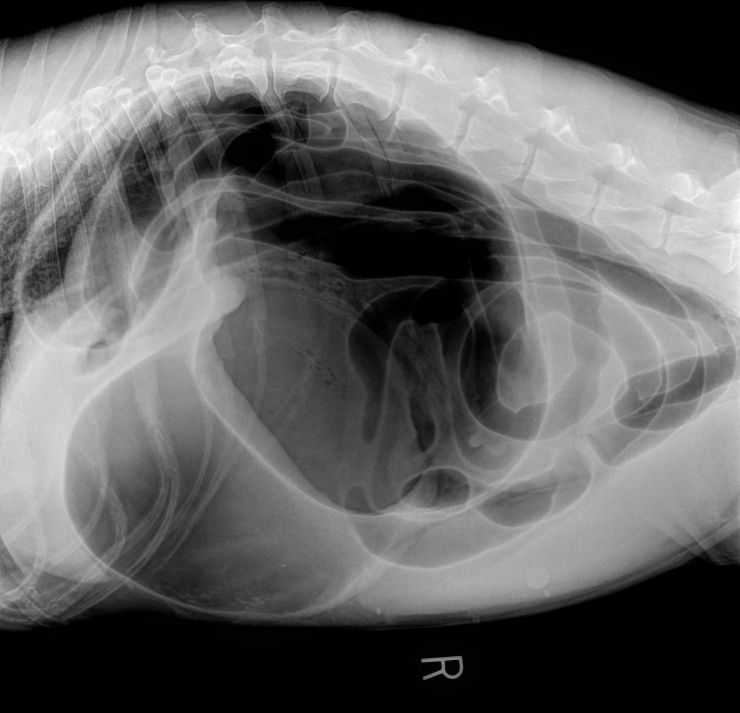What is Bloat?
Gastric Dilatation and Volvulus, also known as GDV or Bloat, is a condition where the stomach dilates or becomes swollen with fluid or air. It’s really a two-part condition, first the dilation of the stomach, and then in many cases, the torsion or twisting of the stomach. It’s the twisting that can become deadly in a hurry.
When the stomach twists, it traps blood from flowing from the stomach to other organs, including the heart. This can cause your dog to go into shock, which is often the cause of death.
You can see the expansion and twisting of the stomach in this illustration, as well as the demeanor of a dog with bloat.

What Are the Signs of Bloat?
Knowing the signs and detecting them quickly can mean the difference between life and death. Initially, your dog may seem like they have an upset stomach. They may:
- Try to vomit but nothing comes up
- Pace
- Seem anxious
- Drool
- Have a swollen stomach
- Look at their own stomach
- Act restless
As their condition worsens they may:
- Collapse
- Have a rapid heart rate
- Have a weak pulse
- Have pale gums
If you think your dog has bloat, get them to the vet immediately.
What Causes Bloat?

Besides the Bloodhound, other large barrel-chested dogs like German Shepherds, Labrador Retrievers, Saint Bernards, Weimaraners and Setters are also at risk. It is the number one cause of death in Great Danes.
And there seems to be a genetic component too. It tends to run in families. If you’re rescuing a dog, there may be no way of knowing if any of the dog’s relatives suffered from the condition. But if you are buying your dog from a reputable breeder, they should be able to tell you about the health history of close relatives.
Although family history can play a role is not completely genetic. The genetic factor may be poor digestion or other stomach issues. Another huge genetic factor can be temperament as nervous high strong animals can be more prone.
There are some other factors that are associated with the onset of bloat. You increase the risk of bloat if:
- You feed your dog one large meal a day
- Your dog eats quickly
- Your dog is very active before or after eating
- Your dog overeats or drinks too much
- Your dog is particularly anxious
- Your dog eats from an elevated bowl
What is the Treatment for Bloat?
Even with treatment, 25-30% of dogs with bloat die, according to peteducation.com.
If your dog has bloat, the vet will first try to release the build-up of gas by inserting a tube into the stomach, or using a large needle if a tube won’t pass. They’ll administer IV fluids if the dog is in shock or shock seems imminent.
Once the dog is stabilized the vet will do an x-ray to see if the stomach has twisted. If it has, surgery is the only solution. They untwist the stomach and stitch it into place (a procedure called gastropexy) so that the stomach can’t twist again. Without this procedure, 75% to 80% of dogs with gastric torsion will get it again.
It sounds like surgery solves the problem and the dog will be fine. But in reality, so much damage is often done to other organs as a result of the blood supply being cut off that surgery is sometimes not enough.
If the damage to other organs is so severe, the dog may die in spite of best efforts to save them.
Can Bloat Be Prevented?
To a degree bloat can be prevented by feeding smaller more frequent meals. It is important to always have large quantities of extra strength Gas-X on hand. If you feel your dog may be uncomfortable or gassy it will never be harmful to give them two extra strength gelcaps and it could potentially save their life.
Just to be clear, bloat does not kill dogs. Torsion does and torsion is the secondary event to bloat. Our purchase contract strongly recommends that your dog be gastropexied at the age of two when they are neutered or spayed. When a gastropexy is done correctly, the sutures have an extremely high success rate of holding. Even if the dog bloats, the stomach stays in place and does not torsion. A gastropexy should be performed by a vet with ample experience. It’s a personal choice whether you opt for laparoscopic or the large incision. A cost of a gastropexy can vary from $600-$1500 CDN. It may seem like a large expense but it is far cheaper and safer to do preventative than to hope for the best when reversing a torsion in an emergency situation.
